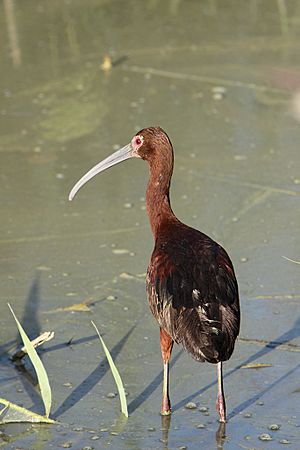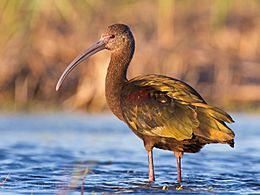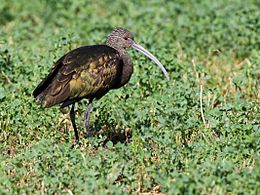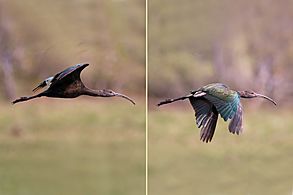White-faced ibis facts for kids
Quick facts for kids White-faced ibis |
|
|---|---|
 |
|
| Breeding plumage | |
| Conservation status | |
| Scientific classification | |
 |
|
| Synonyms | |
|
The white-faced ibis (Plegadis chihi) is a type of wading bird. It belongs to the ibis family, called Threskiornithidae.
This bird lives and raises its young in groups. They build their nests in marshes, often in bushes or low trees. You can find them breeding from the western United States down through Mexico. They also breed in parts of South America, like southeastern Brazil, Bolivia, and central Argentina, and along the coast of central Chile. In winter, they move to warmer areas. Their winter homes stretch from southern California and Louisiana south, covering their breeding areas too.
Contents
What the White-faced Ibis Looks Like
The white-faced ibis looks a lot like the glossy ibis. When they are not breeding, their feathers, called plumage, are very similar. However, the white-faced ibis is usually a bit smaller. Its feathers are also a warmer color.
When they are breeding, adult white-faced ibises have a pink face without feathers. This pink area is outlined with white feathers. They have a grey beak and bright red legs. Their eyes are red all year round. Glossy ibises, on the other hand, have dark eyes. Young white-faced ibises and glossy ibises look almost exactly the same.
Measurements of the White-faced Ibis:
- Length: 18.1 to 22.1 inches (46 to 56 cm)
- Weight: 15.9 to 18.5 ounces (450 to 525 grams)
- Wingspan: 35.4 to 36.6 inches (90 to 93 cm)
Where the White-faced Ibis Lives
The white-faced ibis can be found in Canada, the United States, Central America, and the southern half of South America. In 2012, experts estimated there were about 1.2 million of these birds. Their numbers are growing. The IUCN says this bird is of "Least Concern". This means it is not currently at risk of disappearing.
How the White-faced Ibis Eats
The white-faced ibis eats many different small creatures. These include insects, leeches, snails, crayfish, and earthworms. They might also eat small fish, newts, and frogs. They use their long, curved beaks to poke into the mud and water to find their food.
Reproduction and Nesting Habits
White-faced ibises nest together in groups in marshes. They usually build their nests in bushes or short trees. They prefer parts of the marsh with lots of plants. These plants include bulrush, cattails, shrubs, and small trees. They build their nests using reeds.
A female white-faced ibis usually lays three or four eggs at a time. The eggs are a pretty blue-green color.
How Long White-faced Ibises Live
In zoos or special care, white-faced ibises can live for about fourteen years. In the wild, they usually live for nine years. The oldest wild white-faced ibis ever recorded lived for fourteen years and six months!
Challenges and Protection
In the past, white-faced ibises faced many dangers from people. Studies in the 1960s showed that many birds died from being shot. This was before they were protected by the Migratory Bird Treaty Act of 1918.
The biggest threats used to be harmful chemicals called pesticides and the loss of their homes. A pesticide called DDT made their eggshells very thin and weak. When parent birds sat on the eggs to keep them warm, the eggs would often break. Also, these birds rely on wetlands and marshes for food and nesting. So, pollution and draining of these water habitats caused big problems for them.
To fix these issues, DDT was banned in 1970. Also, different programs were started to protect and care for wetland nesting areas. Because of these efforts, the number of white-faced ibises has increased. However, some people still discuss if all populations of these birds are fully recovered and growing everywhere.
See also
 In Spanish: Morito cariblanco para niños
In Spanish: Morito cariblanco para niños





